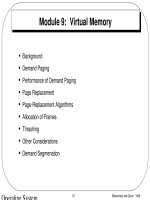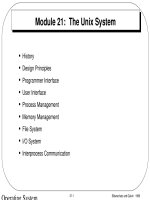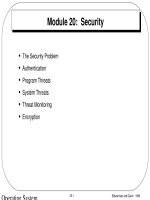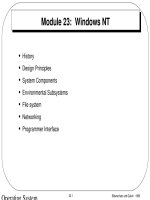Lecture Operating system concepts - Module 20
Bạn đang xem bản rút gọn của tài liệu. Xem và tải ngay bản đầy đủ của tài liệu tại đây (174.45 KB, 11 trang )
Module 20: Security
•
•
•
•
•
•
The Security Problem
Authentication
Program Threats
System Threats
Threat Monitoring
Encryption
20.1
Silberschatz and Galvin 1999
The Security Problem
•
Security must consider external environment of the system, and
protect it from:
– unauthorized access.
– malicious modification or destruction
– accidental introduction of inconsistency.
•
Easier to protect against accidental than malicious misuse.
20.2
Silberschatz and Galvin 1999
Authentication
•
User identity most often established through passwords, can be
considered a special case of either keys or capabilities.
•
Passwords must be kept secret.
– Frequent change of passwords.
– Use of “non-guessable” passwords.
– Log all invalid access attempts.
20.3
Silberschatz and Galvin 1999
Program Threats
•
Trojan Horse
– Code segment that misuses its environment.
– Exploits mechanisms for allowing programs written by users
to be executed by other users.
•
Trap Door
– Specific user identifier or password that circumvents normal
security procedures.
– Could be included in a compiler.
20.4
Silberschatz and Galvin 1999
System Threats
•
•
Worms – use spawn mechanism; standalone program
•
Viruses – fragment of code embedded in a legitimate program.
– Mainly effect microcomputer systems.
– Downloading viral programs from public bulletin boards or
exchanging floppy disks containing an infection.
– Safe computing.
Internet worm
– Exploited UNIX networking features (remote access) and
bugs in finger and sendmail programs.
– Grappling hook program uploaded main worm program.
20.5
Silberschatz and Galvin 1999
The Morris Internet Worm
20.6
Silberschatz and Galvin 1999
Threat Monitoring
•
Check for suspicious patterns of activity – i.e., several incorrect
password attempts may signal password guessing.
•
Audit log – records the time, user, and type of all accesses to an
object; useful for recovery from a violation and developing better
security measures.
•
Scan the system periodically for security holes; done when the
computer is relatively unused.
20.7
Silberschatz and Galvin 1999
Threat Monitoring (Cont.)
•
Check for:
– Short or easy-to-guess passwords
– Unauthorized set-uid programs
– Unauthorized programs in system directories
– Unexpected long-running processes
– Improper directory protections
– Improper protections on system data files
– Dangerous entries in the program search path (Trojan
horse)
– Changes to system programs: monitor checksum values
20.8
Silberschatz and Galvin 1999
Network Security Through Domain Separation Via Firewall
20.9
Silberschatz and Galvin 1999
Encryption
•
•
Encrypt clear text into cipher text.
•
Data Encryption Standard substitutes characters and rearranges
their order on the basis of an encryption key provided to
authorized users via a secure mechanism. Scheme only as
secure as the mechanism.
Properties of good encryption technique:
– Relatively simple for authorized users to incrypt and decrypt
data.
– Encryption scheme depends not on the secrecy of the
algorithm but on a parameter of the algorithm called the
encryption key.
– Extremely difficult for an intruder to determine the encryption
key.
20.10
Silberschatz and Galvin 1999
Encryption (Cont.)
•
Public-key encryption based on each user having two keys:
– public key – published key used to encrypt data.
– private key – key known only to individual user used to
decrypt data.
•
Must be an encryption scheme that can be made public without
making it easy to figure out the decryption scheme.
– Efficient algorithm for testing whether or not a number is
prime.
– No efficient algorithm is know for finding the prime factors of
a number.
20.11
Silberschatz and Galvin 1999









